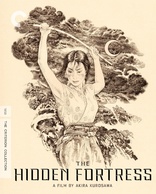The Hidden Fortress Blu-ray Movie
HomeThe Hidden Fortress Blu-ray Movie 
隠し砦の三悪人 / Kakushi-toride no san-akunin / Blu-ray + DVDCriterion | 1958 | 139 min | Not rated | Mar 18, 2014
Movie rating
8.1 | / 10 |
Blu-ray rating
| Users | 4.5 | |
| Reviewer | 4.5 | |
| Overall | 4.5 |
Overview
The Hidden Fortress (1958)
Lured by gold, two greedy peasants escort a man and woman across enemy lines. However, they do not realize that their companions are actually a princess and her general.
Starring: Takashi Shimura, Toshirô Mifune, Minoru Chiaki, Kamatari Fujiwara, Susumu FujitaDirector: Akira Kurosawa
| Foreign | Uncertain |
| Period | Uncertain |
| Adventure | Uncertain |
Specifications
Video
Video codec: MPEG-4 AVC
Video resolution: 1080p
Aspect ratio: 2.39:1
Original aspect ratio: 2.35:1
Audio
Japanese: LPCM Mono
Japanese: DTS-HD Master Audio 5.1
Subtitles
English
Discs
50GB Blu-ray Disc
Two-disc set (1 BD, 1 DVD)
DVD copy
Playback
Region A (locked)
Review
Rating summary
| Movie | 4.5 | |
| Video | 4.5 | |
| Audio | 4.5 | |
| Extras | 4.0 | |
| Overall | 4.5 |
The Hidden Fortress Blu-ray Movie Review
Reviewed by Dr. Svet Atanasov February 20, 2014Akira Kurosawa's "Kakushi-toride no san-akunin" a.k.a "The Hidden Fortress" (1958) arrives on Blu-ray courtesy of Criterion. The supplemental features on the disc include an original trailer for the film; new and exclusive audio commentary by film historian Stephen Prince; archival interview with George Lucas; and a documentary produced by Toho. The release also arrives with an illustrated booklet featuring an essay by film scholar Catherine Russell. In Japanese, with optional English subtitles for the main feature. Region-A "locked".
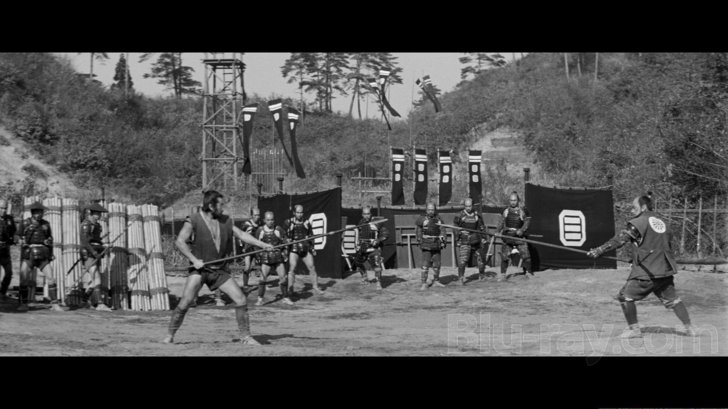
The duel
In a time of war, the greedy peasants Tahei (Minoru Chiaki, Rashomon) and Matashichi (Kamatari Fujiwara, Yojimbo) encounter the great samurai General Rokurota Makabe (Toshiro Mifune), who promises to make them rich if they help him and the beautiful Princess Yuki (Misa Uehara) pass through enemy territory and reach the Hayakawa border. The peasants enthusiastically agree after they discover that General Makabe and Princess Yuki have hidden a large treasure which they plan to take with them.
While passing through the countryside, the four travelers are frequently stopped by enemy warriors looking for Princess Yuki. General Rokurota also meets an old foe, General Tadokoro (Susumu Fujita, Tora! Tora! Tora!), who challenges him to a duel. Then much to the annoyance of General Rokurota, Tahei and Matashichi begin fighting because they cannot agree how to divide the gold that will be given to them once they reach the Hayakawa border.
It is difficult to believe that The Hidden Fortress was Japanese master Akira Kurosawa’s first widescreen film. Indeed, its framing is very effective, especially during large panoramic shots, while the camera movement is notably fluid. Many of Kurosawa’s long zooms also remind of those frequently seen in John Ford’s greatest westerns.
Another interesting aspect of the film’s visual style is the optimization of the available image space. To be perfectly clear, the positioning of the different characters inside the image frame is consistently very precise. There are many examples throughout the film where the camera appears to be following one character but actually observes closely two, three or even a whole group of characters as they interact with each other (see the long duel sequence). Additionally, there are sequences where the movement of different characters which the audience cannot immediately see is anticipated. For example, in the very beginning of the film for a short period of time only Tahei and Matakishi can see the fleeing samurai. In this sequence all of the important movement begins behind the camera and yet Kurosawa still places the audience right in the middle of the action.
Kurosawa also persistently plays with the audience’s expectations as it never becomes quite clear how he feels about Tahei and Matakishi. They are greedy, unreliable, and obviously dangerous (there is a short sequence in which they actually plan to rape the beautiful Princess Yuki) but also poor, weak, and disillusioned, precisely the type of characters he loves to defend in his great period films. On the other hand, Mifune’s General Rokurota is a fearless and loyal warrior but also a bit of cheat with a great sense of humor. Throughout the film, Kurosawa frequently tests these colorful characters and more often than not they genuinely surprise with their reactions.
When Kurosawa’s The Hidden Fortress is discussed it is impossible not to mention George Lucas and his Star Wars. A great admirer of the Japanese master’s work, Lucas has repeatedly said during the years that The Hidden Fortress was in fact his inspiration for Star Wars. The two greedy peasants, Tahei and Matakishi, also directly influenced the creation of the famous droids C3PO and R2D2.
Note: In 1959, The Hidden Fortress won Silver Bear Award for Best Director and FIPRESCI Prize at the Berlin International Film Festival.
The Hidden Fortress Blu-ray Movie, Video Quality 
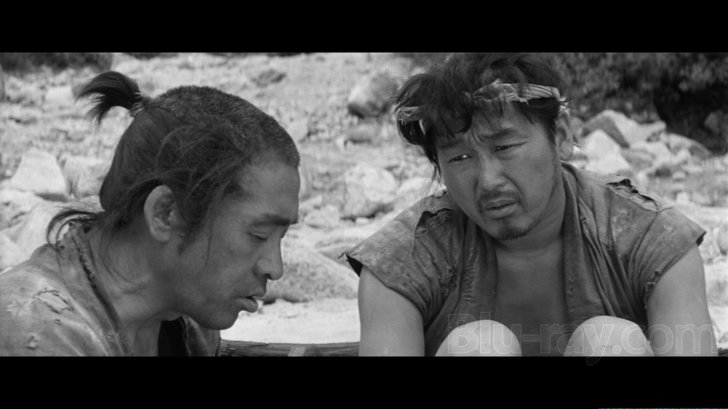
Presented in an aspect ratio of 2.39:1, encoded with MPEG-4 AVC and granted a 1080p transfer, Akira Kurosawa's The Hidden Fortress arrives on Blu-ray courtesy of Criterion.
The following text appears inside the booklet provided with this Blu-ray release:
"This new digital transfer was created in 2K resolution on a DFT Scanity film scanner from the original 35mm fine-grain master positive; the original negative for this film no longer exists. Thousands of instances of dirt, debris, scratches, splices, and warps were manually removed using MTI's DRS, while Digital Vision's Phoenix was used for small dirt, grain, noise management, jitter, and flicker.
The original monaural soundtrack was remastered at 24-bit from a 35mm optical soundtrack print. Clicks, thumps, hiss, and hum were manually removed using Pro Tools HD. Crackle was attenuated using AudioCube's integrated workstation. The alternate 3.0 surround soundtrack was decoded through a Perspecta integrator to a create a simulated stereo stereo LCR soundtrack. Though only three channels of audio are present, the Perspecta soundtrack was encoded as 5.1 on the disc to maintain compatibility with legacy players.
Transfer supervisor and colorist: Lee Kline.
Scanning: Imagica, Tokyo."
Excluding some very minor contrast and brightness fluctuations, which appear to be inherited, Criterion's new 2K restoration of The Hidden Fortress is outstanding. The overwhelming majority of the close-ups boast terrific depth (see screencapture #2), while the large panoramic shots convey excellent fluidity. Even in areas where light is restricted clarity and sharpness remain very pleasing (see screencaptures #9 and 10). Color saturation and stability are excellent and there are no traces of digital boosting. Furthermore, there are no traces of compromising degraining and sharpening adjustments. A few extremely light scratches remain, but large debris, cuts, damage marks, and stains have been carefully removed. Also, it is very easy to see that different stabilization adjustments have been performed because there are no serious transition and stability issues. The encoding and compression are very good. All in all, this is a terrific presentation of The Hidden Fortress which is likely to remain the film's definitive presentation on the home video market. (Note: This is a Region-A "locked" Blu-ray release. Therefore, you must have a native Region-A or Region-Free PS3 or SA in order to access its content).
The Hidden Fortress Blu-ray Movie, Audio Quality 
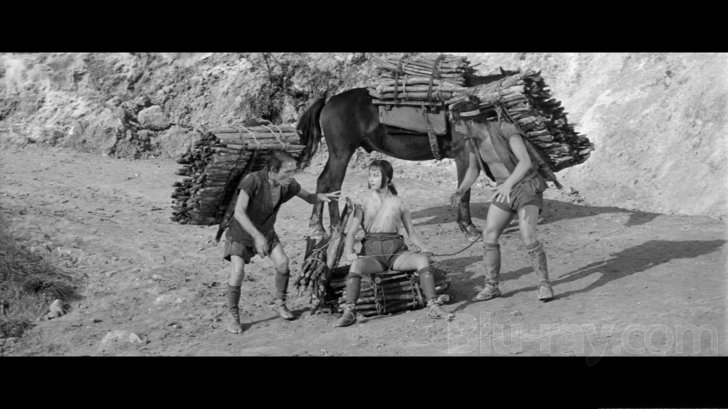
There are two standard audio tracks on this Blu-ray release: Japanese LPCM 1.0 and Japanese DTS-HD Master Audio 5.1 (preserving the original Perspecta simulated stereo effects). For the record, Criterion have provided optional English SDH subtitles for the main feature. When turned on, they appear inside the image frame.
I encourage you to experiment with the two lossless tracks. I prefer the lossless mono track, but the stereo effects on the second lossless track clearly open up the film in a number of important areas. In terms of dynamic intensity, both tracks handle the film exceptionally well. The range of nuanced dynamics on the mono track, in particular, is surprisingly good. Additionally, different stabilization adjustments have been performed as the dialog is very stable and free of problematic dynamic fluctuations. The English translation is very good.
The Hidden Fortress Blu-ray Movie, Special Features and Extras 
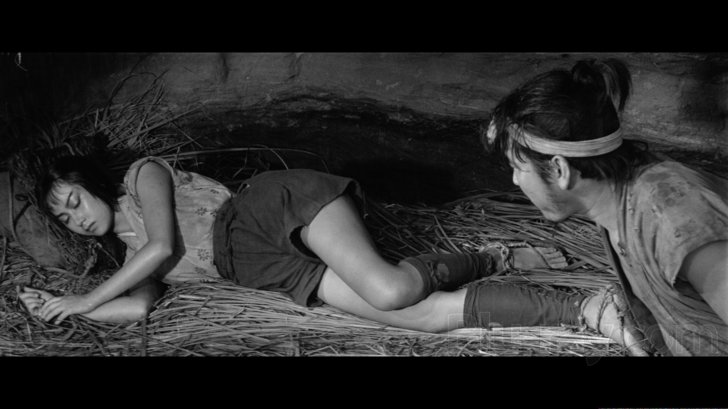
- Trailer - original trailer for The Hidden Fortress. In Japanese, with optional English subtitles. (4 min, 1080/60i).
- Akira Kurosawa: It is Wonderful to Create - this documentary was initially introduced through the Toho Masterworks series Akira Kurosawa: It Is Wonderful to Create in 2003. In it the legendary Japanese director explains how John Ford influenced his work, and discusses the style and cinematography of The Hidden Fortress. Also included are various clips from archival interviews with actors Misa Uehara (Princess Yuki) and Takeshi Kato (the fleeing samurai), production designer Yoshiro Muraki, set decorator Koichi Hamamura, and director Masahiro Takase, amongst others. In Japanese, with optional English subtitles. (41 min, 1080/60i).
1. John Ford and format
2. Casting
3. Challenges
4. Horses
5. Swords and speed
6. Key collaborators
- George Lucas on Akira Kurosawa - in this video interview, George Lucas recalls how and where he was first exposed to the films of Akira Kurosawa and discusses their unique visual style. Mr. Lucas also discusses some of the similarities between The Hidden Fortress and his Star Wars. The interview was conducted exclusively for Criterion in 2001. In English, not subtitled. (9 min, 1080i).
- Commentary - film historian Stephen Prince, author of The Warrior's Camera: The Cinema of Akira Kurosawa, discusses the unique framing of The Hidden Fortress, Akira Kurosawa's first widescreen film, its influence on Sergio Leone's The Good, the Bad and the Ugly, the tone of the film, etc. The audio commentary was recorded exclusively for Criterion in 2013.
- Booklet - an illustrated booklet featuring an essay by film scholar Catherine Russell.
The Hidden Fortress Blu-ray Movie, Overall Score and Recommendation 
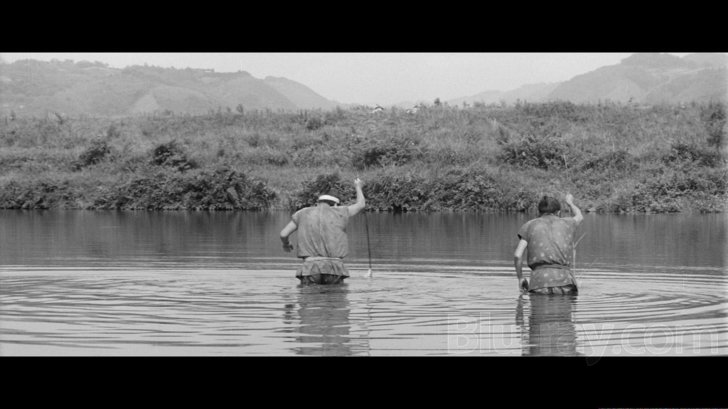
It is probably quite difficult to tell now because Akira Kurosawa's films are so easily accessible and have been compared for years, but if one were to see them for the first time and in chronological order, one would be shocked to discover just how incredibly well lensed the Japanese master's first widescreen film, The Hidden Fortress, is. Some of the framing and camera movement in this film is on par with what contemporary directors have done with modern technology. Criterion's technical presentation of The Hidden Fortress is terrific. Recently restored in 2K, the film clearly looks the best it ever has. HIGHLY RECOMMENDED.
Other editions
The Hidden Fortress: Other Editions
Similar titles
Similar titles you might also like

Throne of Blood
蜘蛛巣城 / Kumonosu-jô
1957

Red Beard
赤ひげ / Akahige
1965

Sansho the Bailiff
山椒大夫 / Sanshô dayû
1954

Harakiri
切腹 / Seppuku
1962

Ikiru
生きる
1952

Tampopo
タンポポ / Tanpopo
1985

Dragon Inn
龍門客棧 / Long men kezhan
1967

Monsieur Hulot's Holiday
Les vacances de Monsieur Hulot / 1953 and 1978 Versions
1953

The Spiders
1919-1920

Shoah: Four Sisters
Les quatre soeurs
2018

Jour de fête
The Big Day / 1949, 1964, and 1995 Versions
1949

The Gardener
2012

The Silence
1998

Mon Oncle
My Uncle / French and English Versions
1958

I'll Be Alone After Midnight
Je Serai Seule Après Minuit
1931

Trafic
Traffic
1971

Seven Samurai 4K
七人の侍 / Shichinin no samurai
1954

Up to His Ears
Les tribulations d'un Chinois en Chine
1965

Arabian Nights: Volume 1 - The Restless One
As Mil e Uma Noites: Volume 1, O Inquieto
2015

PlayTime
4K Restoration
1967
